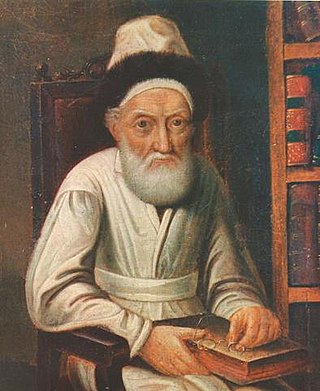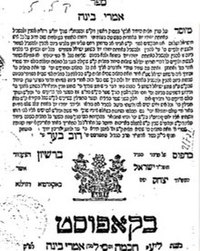
Chabad, also known as Lubavitch, Habad and Chabad-Lubavitch, is an Orthodox Jewish Hasidic dynasty. Chabad is one of the world's best-known Hasidic movements. It is one of the largest Hasidic groups as well as one of the largest Jewish religious organizations in the world. Unlike most Haredi groups, which are self-segregating, Chabad mainly operates in the wider world and it caters to secularized Jews.

Menachem Mendel Schneersohn also known as the Tzemach Tzedek was an Orthodox rabbi, leading 19th-century posek, and the third rebbe of the Chabad Lubavitch Hasidic movement.

Schneersohn is a Jewish surname used by many of the descendants of the Rabbi Shneur Zalman of Liadi, the first Rebbe of the Chabad-Lubavitch Hasidic movement.

Sholom Dovber Schneersohn was the fifth Rebbe of the Chabad Lubavitch chasidic movement. He is known as "the Rebbe Rashab". His teachings represent the emergence of an emphasis on outreach that later Chabad Rebbes developed into a major theme.
Dovber Schneuri was the second Rebbe of the Chabad Lubavitch Chasidic movement. Rabbi Dovber was the first Chabad rebbe to live in the town of Lyubavichi, the town for which this Hasidic dynasty is named. He is also known as the Mitteler Rebbe, being the second of the first three generations of Chabad leaders.

Tomchei Tmimim is the central Yeshiva of the Chabad-Lubavitch Hasidic movement. Founded in 1897 in the town of Lubavitch by Rabbi Sholom Dovber Schneersohn, it is now an international network of institutions of advanced Torah study, the United Lubavitcher Yeshivoth.

Strashelye was a branch of the Chabad school of Hasidic Judaism, named after the town Strashelye (Starasel'lye) in the Mohilev Province of present-day Belarus, where its leader lived. Like all Hasidism it is based on the teachings and customs of Chasidut as taught by the Baal Shem Tov, in turn based on the Kabbalistic works of Rabbi Isaac Luria.
Chana Schneerson was the wife of Rabbi Levi Yitzchak Schneerson, a Chabad Hasidic rabbi in Yekatrinoslav, Ukraine and the mother of the seventh Chabad-Lubavitch Rebbe, Rabbi Menachem Mendel Schneerson.

Chabad offshoot groups are those spawned from the Chabad Hasidic Jewish movement. Many of these groups were founded to succeed previous Chabad leaders, acting as rivals to some of the dynastic rebbes of Chabad. Others were founded by former students of the movement, who, in forming their own groups, drew upon their experiences at Chabad.

The Niezhin branch of the Chabad Hasidic movement was founded after the death of the third rebbe of Chabad, Rabbi Menachem Mendel Schneersohn. The group was one of several that sought to succeed Rabbi Menachem Mendel, whose death created a dispute over his succession. The group was led by its founder, Rabbi Yisroel Noach of Niezhin, a son of Rabbi Menachem Mendel.

Chabad philosophy comprises the teachings of the leaders of Chabad-Lubavitch, a Hasidic movement. Chabad Hasidic philosophy focuses on religious concepts such as God, the soul, and the meaning of the Jewish commandments.

Chabad customs and holidays are the practices, rituals and holidays performed and celebrated by adherents of the Chabad-Lubavitch Hasidic movement. The customs, or minhagim and prayer services are based on Lurianic kabbalah. The holidays are celebrations of events in Chabad history. General Chabad customs, called minhagim, distinguish the movement from other Hasidic groups.

Yom Tov Shel Rosh Hashana: 5666, known in Chasidic reference as Samech Vov, is a compilation of the Chasidic treatises by Rabbi Sholom Dovber Schneersohn, the fifth Rebbe of Chabad, from the Hebrew year 5666 (1905–06). This series of Chassidic essays is considered a fundamental work of Chabad mysticism. The Samech Vov series is one of the single largest works of Chabad philosophy. The work is titled as Yom Tov Shel Rosh Hashana after the opening words of the first treatise. The work is also referred to as Hemshech Samech Vov.

Toras Chaim is a two-volume work of Hasidic discourses on the books of Genesis and Exodus by the second Chabad Rebbe, Rabbi Dovber Schneuri. The work is arranged in a similar fashion as Likutei Torah/Torah Or, a fundamental work on Chabad philosophy authored by Rabbi Dovber's father, Rabbi Shneur Zalman of Liadi, the founder of the Chabad movement. Both works are arranged according to the weekly Torah portion.
Chaya Mushka Schneersohn was the daughter of Rabbi Dovber Schneuri, the second Rebbe of the Chabad Hasidic movement, and the wife of Rabbi Menachem Mendel Schneersohn the third Rebbe.

Sefer Hamamaarim 5672, or Ayin Beis, is a compilation of the Chasidic treatises by Rabbi Sholom Dovber Schneersohn, the fifth Rebbe of Chabad, from the Hebrew year 5672 (1911-12). This series of Chassidic essays are considered a fundamental work of Chabad mysticism for its original treatment of many Chassidic concepts. The Ayin Beis series is one of the single longest works of Chabad philosophy. The work is also referred to as Hemshech Ayin Beis.

Hatomim was a scholarly journal published by the Chabad-Lubavitch Hasidic movement. The journal was published under the direction of the sixth Rebbe of Chabad, Rabbi Yosef Yitzchak Schneersohn. The journal published articles on Chabad philosophy and Talmud.

Dirah betachtonim, is a significant theological concept in Chabad philosophy describing the ultimate desire of God as relating to the manifestation of the divine presence within the material world.

Derech Chaim is a work on the subject of repentance by the second Rebbe of the Chabad Hasidic movement, Rabbi Dovber Schneuri.

Yisroel Jacobson (1895-1975) was a Chabad Hasidic rabbi and the representative of the sixth Chabad rebbe, Yosef Yitzchak Schneersohn, to the United States during the 1920s and 1930s. He was one of the first Lubavitcher activists to arrive in to the United States. He was born in Russia and migrated to the United States in 1925.










